Phoenix Boxing
What boxing experience can teach a karate-ka
By Christopher Caile
Author's Note: The author's own concepts and observations about the differences between boxing, karate and techniques within traditional Okinawan kata are added to the article within the photo captions, Author's Notes at the end of the article, and occasionally within the text. They are not necessarily shared by Phoenix Carnevale or Mike Smith.
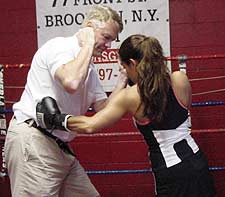
Phoenix Carnevale angles off the center line and hooks a punch into the floating ribs of the author, Chris Caile. By angling and using an outside hook punch a boxer can get inside the reach of a bigger opponent to strike from an angle that can penetrate the defender's arms if they are not well positioned.
It was already 90 degrees outside by 9:00 in the morning when I walked upstairs to Gleason's Gym. Gleason's, the world famous boxing gym, is on the second floor of a commercial building sitting virtually under the end of the Brooklyn Bridge in Brooklyn, NY.
As I entered I could see about 30 people training in a large unobstructed room scattered with boxing rings.
There was the pop, pop of gloves hitting into bags, and the steady tick of jump ropes hitting the floor in regular cadence. Others were shadow boxing, and in several rings trainers were holding up target mitts for fighters to hit.

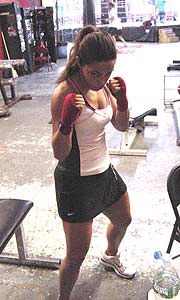
In a karate fighting stance (left) Phoenix's body is angled almost sideways (about 80 degrees), one leg behind the other, with the body more open and her hands lower, the left hand extended forward. The stance, while stable, is best positioned for forward and back movement, but not so for movement to the side. Likewise her hands and arms are not positioned to effectively block head strikes, but can easily be used to counter a variety of kicks. Many point fighters turn there body even further to the side to protect their target area, but if they are participating in semi contact sparing their stance is more like a boxer. In a boxing stance (right), Phoenix's body angle is more like 45-55 degrees, allowing for movement in any direction. During boxing the stance is also very flexible and is adjusted to need. Her hands are also held higher protecting her head, while the forearms protect the ribs on both sides.
I was there to talk to Phoenix Carnevale, a Seido Karate student, and a kick boxing and fitness teacher, who is training for the New York City Golden Gloves championship. I found her in a back corner of the gym with her trainer, Mike Smith. Mike is the gym's mixed martial arts stand-up coach. He is a former Oyama Karate student, who in addition to boxing also regularly trains in Machaddo Brazilian Jujutsu. At the gym he has worked with such notables as the Gracies and members of the International Fight League.

Mike and Phoenix jockeying for position in the ring. Each constantly moves, circles, angles and adjusts against the other, trying to get positional advantage, create an opening or elude the techniques of the other. Developing this type of fluid body movement can be very helpful to any karate-ka to help them avoid attacks instead of just relying on blocking. Success and failure depend upon who achieves the better positioning and wins the fight to control the space between them. Most modern day karate fighters in free fighting and competition use the same tactics, but old style Okinawan kata taught a different principle: Using blocks, grabs, strikes to nerve points, off balancing and other techniques to take control of the opponent's body and thus his actions in order to counter. (1)

Boxers live in a close-in tumble world of arms length punches, hard blows and counters. It can be brutal. Modern day Karate-ka most often spar at a greater distance where arms don't reach the opponent unless there is movement, but kicks do. Taekwondo practitioners fight at even a farther distance relying primarily on leg techniques. Both are usually very uncomfortable with close-in fighting. They are not used to it and feel uncomfortable. In addition they are not used to really getting hit, unless they are from a semi contact style or are involved in mixed martial arts. Interestingly, however, old style Okinawan karate kata includes close in self-defense and combat techniques.
I asked them to comment on the difference between karate free fighting and boxing, especially in the use of the hands. Mike commented that all martial arts have core principles, "but in boxing the fighter is doing it for a living. The fighter gets to test what he is doing, then make adjustments. They do this all in real time against a partner who is trying to hit them. "Thus the real difference," Mike said, "is that boxers have real time experience and constant training. They also get feedback when they do things wrong."


As her trainer Mike Smith moves around the ring, Phoenix Carnevale moves to follow, hitting a hand held target mitt with a left punch and right cross, constantly adjusting to Mike's movement. This allows her to develop her techniques within a dynamic, moving environment. While traditional karate kata always included movement with striking, modern karate classes often drill punches from static positions. This tendency tends to slow the karate-ka's development and coordination of movement (and adjustment) with punches (or kicks), something which is critical to effective sparring. (2)
"What this means in my training," said Phoenix, "is fluidity." She noted that when she started boxing, she was really tight and not relaxed and fluid. "In karate, especially in kata, we assume rather ridged positions and when we punch, the punch is often held out extended. Against a boxer, if I kept my arm extended, it would be quickly picked up and would invite a counter to my face. Not good." (3)


Phoenix positions her body and slightly moves her head to slip right and left punches from Mike. Moving the head to avoid a punch is faster than intercepting a punch with an arm block in karate. This is because once a defender sees an attack coming (visual perception), the muscles of the neck can be moved more quickly than the arm (they are closer to the brain, movement is smaller and reflexive), rather than being dependent on spatial judgment as to range and interception angle (used with arm blocks). But there is a disadvantage too – the attack is avoided but not interrupted. A second attack can follow.
"My dad always told me to take up karate," Phoenix added, "but he also said box too." Boxing, especially sparring, builds up an expertise in timing and distancing, and teaches you to move your body and head. You can get some of this too in karate free fighting, but it is very different when you are getting hit and the opponent isn't kicking from a distance but is instead hitting for your head. (4)
In karate practice, Mike noted, you punch, kick and block in groups, usually lined up, and practice these moves from a static position. You don't get the movement and footwork of movement from which to do these techniques.

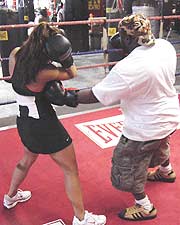
To create an opening for a punch, Mike Smith angles to the left off the center line of Phoenix Carnevale and executes a left hook to her head. The natural reaction is to lift the arms, creating a gap underneath and to the side. This technique is immediately followed by a second left hook to the exposed ribs. Mike noted that a hook to the ribs alone probably wouldn't be successful. "You need the first technique," he said, "to set up the second." Karate students are taught straighter, more direct punching. Many, however, do adopt boxing-like hooks and angular movement. On the street, however, the straight karate punch can be surprisingly effective. It doesn't provide many visual clues to its use, and it is direct, fast and powerful. And unless trained, many attackers won't recognize what is happening until too late. (5)
Boxing, Phoenix said, is a martial art just like karate. Nike agreed. "But don't get confused," he added, "Boxing is not for street self-defense or combat. On the street you are just as likely to get ambushed from behind with a weapon. And attackers often come in groups. On the street, people don't match off. "If you aren't careful someone will hit you from behind with something. And if there is a knife, you often won't see it until you are cut."
Boxing is instead based on one-on-one with rules," Mike added. He also advises students not to strike with a fist to the face or head if in a street fight. He has seen too many hands broken that way. For him the effective head strike is done with the palm of the hand. Karate, however, does often contain self-defenses against holds and grabs, he noted, something not allowed or practiced in boxing.
"Another big advantage boxers have is conditioning," Phoenix noted. When she first started Mike tested her, having her do 10 rounds. "He kept telling me to relax and breathe in through my nose," she said.
"You need more work on this," Mike kept saying. He used an old martial arts term, "kime." Phoenix was puzzled. When she asked, "What's that?" Mike said to ask her karate teacher, Kaicho Tadashi Nakamura (founder of the Seido World Karate Organization) about the term. Nakamura is famous as a fighter. As a student of Mas Oyama (Kyokushin) is the early 1960s as part of a three-man team in a challenge match with Thailand, he beat the Thai lightweight full contact champion. (Thai fighters not only use their fists, but knees and elbows too in addition to powerful low kicks to the legs and thighs). He was the perfect person to ask.
Phoenix said that Nakamura sat down and talked to her for quite a while. But what he said was very different from what she expected. Explanations of "Kime" usually refer to the focus of physical and psychological forces into the point of contact (strike point). In physical terms this refers to the sequential powering of legs, hips, trunk and arms as a coordinated unit to maximum arm speed. Karate practitioners are often also taught to momentary tighten at the moment of contact to add body mass behind the fist (or other striking body part) to maximize impact and penetration.
Later in the week I asked Kaicho about what he said to Phoenix (Kaicho Nakamura is also my teacher). He said that he provided a broader explanation than what most associate with the word. He noted that Phoenix has a very focused personality and when fighting she is constantly on attack. "But kime," he noted, "requires a type of balance. To achieve a focused attack, you also have to be relaxed physically and mentally. You also have to pick your opportunities while focusing on the opponent. This way you can see and anticipate your opponent and his attack and you can respond more quickly and counter more powerfully – with concentrated, focused power (kime)."
Kaicho also noted a secondary advantage. "This way you also preserve your energy. You will not tire yourself out with constant tension and expulsion of energy. And you will also be able to use that energy more effectively when needed."
"Kime implies its opposite. This is the bigger picture," said Kaicho
"For me that was hard to do," said Phoenix, "but I am working on it. My strength is my technique and the power of my punches, so I have to learn to relax and pick my opportunities and not always be on the attack."
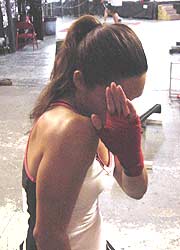
Phoenix demonstrates how the shoulder can be lifted to protect the jaw.
Phoenix is also working on her angles — learning how to angle the body (not keeping it square to the opponent), learning how to angle off the center line, how to turn the body and lift the shoulder, to shed off blows to the head, to shift and duck and slip – to avoid flurries of punches that could overwhelm her.
"I'm not a big person and am usually shorter, with a shorter reach, than my opponent," Phoenix explained. "I can't go head to head. Instead I have to get inside or come at angles, any way to overcome the reach or weight advantage of my opponent."
The range used in boxing is very different from karate. "For the most part, karate practitioners aren't used to the close distance that fighters use. They adjust further away for kicking. They also tend not to protect their head, something that is vital in boxing.
"Most karate student only protect their body from punches," Phoenix added. "On the street they would be vulnerable. And they don't usually learn the skills of slipping head punches, ducking, or weaving. Karate students should practice these skills."
While boxers use just a few weapons (jab, straight punch, hook and upper cut), they also often angle their upper bodies forward or to the side along with angled positioning and hook punches to create avenues of attack. Karate attacks are usually more direct and karate-ka not used to this movement can find themselves vulnerable to these type attacks. (6) Traditional karate practitioners usually keep the trunk vertical, moving the whole body as a unit, and punches are more direct. Karate, however, has more total weapons. Karate-ka can also grab, pull, sweep or trip (in addition to kicks, knees and elbows) and techniques can also be used in a variety of distances. Where a boxer might clinch to control an attack, on the street a karate ka could employ an elbow, knee, foot stomp or head butt. In this way karate is in some ways more flexible than boxing, but within the range of a boxer, and limited to boxer tools, the boxer has the advantage.
When asked about her training, Phoenix said it consists of three rounds of shadow boxing, which often is fairly static in terms of footwork. This is followed by three rounds in the ring with Mike, moving, punching and reacting to his moves –building up her reflexes and reactions. Twice a week she also spars and every day she does 45 minutes to an hour of cardiovascular work. She adds periodic explosive weight training with light weights. "With karate I used to take just a few one hour training and sparring classes a week," she said. "The intensity of training and the conditioning are different."
"Another difference between her boxing and karate training," Phoenix noted, "is that in boxing we learn to absorb punches, slip them or roll off, rather than trying to block them as in karate. In boxing you are also going to get hit, and you learn not to be startled by it or lose your composure. It's part of your training and conditioning. In karate, training often does not include this aspect. Most karate practitioners can't continue if they really get hit. They aren't trained to take a punch."
"I would like to add something here," Phoenix said. "Boxing and karate each have their own techniques and rules. I love them both, and both have their benefits. Boxing has something to teach the karate student if he or she is interested, and karate has added techniques, such as kicking and close range elbows and knees, that could help a boxer on the street."
I then asked Mike about working with Phoenix.
"I like to work with Phoenix," Mike said. "She has will power. She comes in every day, to practice, to train in her technique, over and over. That is dedication. That is the really hard part."
Author's Notes:
(1) Boxers use movement and positioning to elude their opponent's attack or to create an opening for attack. The strategy of karate, as found in traditional kata (not usually point free fighting), is different. While movement is used to avoid getting struck, it is just as important to control the attack in order to interrupt the opponent's movement and limit further attacks. Thus instead of absorbing a punch with the shoulder, arm or fist (with glove) as in boxing, traditional karate kata teach how to simultaneously block and counter while controlling the attacker's body. This is combined with whole body movement. In short, you take over control of the opponent. Thus an important strategy of boxing is positioning, while in karate it is controlling. This does not mean that a boxer doesn't try to control his opponent. For example, when in the ring a boxer I would almost always follow a jab aimed at his head with a counter-jab to his opponent. This counter is effective in interrupting the opponent's secondary attack, such as a follow up cross. Likewise movement and angling help gain control since they are used to avoid or set up an attack. A boxer will also clinch so as to tie up his opponent's arms. This is a way of stopping (controlling) the opponent's attack. In karate, however, traditional kata illustrate how blocking and countering can blossom into control and positioning of the opponent's body through his reflex responses and loss of balance. This is a much more hands on approach.
(2) The problem with static positioning is not just relegated to karate punching drills. In 1994 I accompanied my aikido teacher Roy Suenaka, founder of Wadokai-Aikido, on a trip to Japan to work with and meet many of his old aikido buddies who trained with him while studying with Morihei Ueshiba, the founder of aikido, and Koichi Tohei, who was largely responsible for synthesizing a coherent aikido curriculum while under Ueshiba. In many of the schools (styles) we visited, students were taught to assume certain stances and positions in response to specific attacks. While perhaps useful in basic assimilation of techniques, it struck me as also inhibiting. Instead, I said to myself, you should be able to defend yourself against any attack using any defense chosen from whatever position you are in. What these teachers where teaching was static positioning.
(3)Boxers use padded gloves and often use a flurry of punches. They also avoid the most dangerous targets such as the throat, neck, back of the head, eyes, etc. A karate person if attacked will use his or her bare hands, and a powerful technique if properly targeted can end the confrontation in a single counter attack. In old style Okinawan Shorin-ryu karate an extended arm is also often used with an open palm to block the opponent's eye sight, or control an arm, fist or shoulder, something not usually done in boxing. A boxer will sometimes, however, jab to control an opponent, block eye sight or to judge proper range.
(4) I remember vividly the first time I sparred in a ring against another boxer. There was this sudden rush of realization: "This guy is trying to take my head off. " At first you almost panic and go into defensive mode. Most karate-ka when finding themselves in the middle of a real fight or attack just are not used to the distance or violence. In order to be able to use your karate technique, or boxing skills, you have to practice in like circumstances. You should learn how to react to head punches, how to absorb blows, how to respond to grabs and pushes, how to fight more than one individual and how to fight from any position, especially with hands down (as if talking). This position, it should be noted, is the starting and ending position of all karate kata (although there are various hand positions used within various kata).
(5) Being direct and coming from the center, the punch can travel to the head straight on. This type of punch does not provide a defender with the visual clues given by looping or circular punching or the initial shoulder movement that foretells a technique launch. Furthermore the human eye is attuned to picking up movement on the periphery of vision. The straight punch to the face does not provide this clue and unless practiced in picking up this type of straight counter attack, the opponent can easily totally miss initial signals of launch. In addition if the defender is close to the attacker with his hands down, a reactive straight center counter karate punch will most often move under the attacker's circle of vision which can be blocked (unless the head is tilted forward) by the protrusion of the cheek bone that lies under and in front of the eye socket.
About the Author Christopher Caile
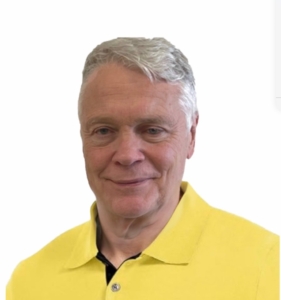
Screenshot
Christopher Caile is the Founder and Editor-In-Chief of FightingArts.com. He has been a student of the martial arts for over 65 years.
He first started in judo while in college. Then he added karate as a student of Phil Koeppel in 1959 studying Kempo and Wado-Ryu karate. He later added Shotokan Karate where he was promoted to brown belt and taught beginner classes. In 1960 while living in Finland, Caile introduced karate to that country and placed fourth in that nation's first national judo tournament.
Wanting to further his karate studies, Caile then hitch hiked from Finland to Japan traveling through Scandinavia, Europe, North Africa, the Middle East and South and Southeast Asia — living on 25 cents a day and often sleeping outside.
Arriving in Japan (1962), Caile was introduced to Mas Oyama and his fledgling full contact Kyokushinkai Karate by Donn Draeger, the famous martial artist and historian. Donn also housed him with several other senior international judo practitioners. Donn became Caile's martial arts mentor, coaching him in judo and introducing him to Shinto Muso-ryu under Takaji Shimizu.
Caile studied at Oyama's honbu dojo and also at Kenji Kurosaki's second Tokyo Kyokushinkai dojo. In his first day in class Oyama asked Caile to teach English to his chief instructor, Tadashi Nakamura. They have been friends ever since. Caile also participated in Oyama's masterwork book, "This Is Karate."
Caile left Japan with his black belt and designation as Branch Chief, the first in the US to have had extensive training in Japan directly under Oyama Sensei. As such, Oyama Sensei asked him to be his representative on visits to his US dojos to report on their status.
A little over a year later, Nakamura, Kusosaki and Akio Fujihira won an epic David vs. Goliath challenge match against Thailand's professional Muay Thai Boxers in Bangkok, Thailand, thrusting Kyolushinkai and Nakamura into national prominence.
Back in the US Caile taught Kyokushinkai karate in Peoria, Il while in college and later in Washington, DC. while in graduate school. Durimg this time Shihan Nakamura had moved to New York City to head Kyokushinkai's North American Operation.
In 1976 when Kaicho Tadashi Nakamura formed the World Seido Karate organization, Caile followed. Living then in Buffalo, NY, Caile taught Seido karate and self-defense at the State University of New York at Buffalo (SUNY Buffalo) for over 15 years where he also frequently lectured on martial arts and Zen in courses on Japanese culture.
Caile moved to New York City in 1999 to marry Jackie Veit. He is now an 8th degree black belt, Hanshi, training in Seido Karate's Westchester, NY Johshin Honzan (Spiritual Center) dojo. In Seido Caile is known for his teaching of and seminars on kata applications. He also produced a 14 segment video series on Pinan kata Bunkai currently available to Seido members.
Caile is also a long-time student and Shihan in Aikido. He studied in Buffalo, under Mike Hawley Shihan, and then under Wadokai Aikido's founder, the late Roy Suenaka (uchi deshi under Morihei Ueshiba, founder of Aikido and was Shihan under Tohei Sensei). In karate, Suenaka (8thdan) was also an in-house student of the Okinawan karate master Hohan Soken.
Having moved to New York City, Caile in 2000 founded this martial arts educational website, FightingArts.com. Twenty-five years later, in 2025, it underwent a major update and revision.
For FightingArts.com and other publications Caile wrote hundreds of articles on karate, martial arts, Japanese art, Chinese Medicine and edited a book on Zen. He also developed relationships with a cross section of leading martial arts teachers. Over the last four decades he has conducted extensive private research into karate and martial arts including private translations of the once secret Okinawan hand copied and passed on Kung Fu book, the Bubishi, as well as an early karate book by the karate master Kenwa Mabuni. He periodically returns to Japan and Okinawa to continue his studies and participate Seido karate events. In Tokyo he practiced (with Roy Suenaka Sensei) in a variety of aikido organizations with their founders – including private interviews and practices at the Aiki-kai Aikido Honbu dojo with the son and grandson of aikido's founder, Doshu (headmaster) Kisshomaru (an old uchi-deshi friend) and his son, Moriteru Ueshiba and in Iwama with Morihiro Saito. On Okinawa he studied Goju Ryu karate under Eiichi Miyazato, 10th dan founder of Naha's Jundokan, and also with Yoshitaka Taira (who later formed his own organization, who specialized in kata Bunkai. While there Caile also trained with Hohan Soken's senior student, Master Fusei Kise, 10 dan as well as with the grandson of the legendary karate master Anko Itosu.
Caile's other martial arts experience includes: Diato-ryu Aikijujitsu and Kenjitsu, kobudo, boxing, Muay Thai, MMA, Kali (empty hand, knife and bolo), study of old Okinawan Shoran-ryu & Tomari body mechanics, study of old Okinawan kata under Richard Kim, study of close quarter defense and combat, including knife and gun defenses, Kyusho Jitsu and several Chinese fighting arts including 8 Star Praying Mantis, Pak Mei (White Eyebrow), and a private family system of Kung Fu.
Caile is also a student of Zen as well as a long-term student of one branch of Traditional Chinese Medicine, Chi Kung (Qigong). As one of two senior disciples of Chi Kung master Dr. Shen (M.D., Ph.D.) Caile was certified to teach and practice. This led to Caile's founding of the The Chi Kung Healing Institute on Grand Island, NY. In Western NY, he also frequently held Chi Kung seminars, including at SUNY Buffalo and at the famous Chautauqua Institution in Chautauqua, NY. His articles on Chi Kung also appeared in the Holistic Health Journal and in several books on alternative medicine.
Caile holds a BA in International Studies from Bradley University and MA in International Relations with a specialty in South and Southeast Asia from American University in Washington, D.C. While in Buffalo, NY he also studied digital and analog electronics.
In his professional life Caile also worked in public relations and as a newspaper reporter and photographer. Earlier he worked in the field of telecommunications including Managing a Buffalo, NY sales and service branch for ITT. He then founded his own private telephone company. This was followed by creation of an electrical engineering company that designed and patented his concept for a new type of low-cost small business telephone system (which was eventually sold to Bell South). The company also did contract work for Kodak and the US space program. Simultaneously Caile designed and manufactured a unique break-apart portable pontoon boat.
Most recently Caile co-founded an internet software company. Its products include software suites with AI capability for control and management of streaming media, such as video and music, an all-in-one book publishing software product for hardcover, eBook and audio book creation and security software for buildings and government use.
For more details about Christopher Caile's martial arts, work experience and life profile, see the About section in the footer of this site.
Search for more articles by this author:






